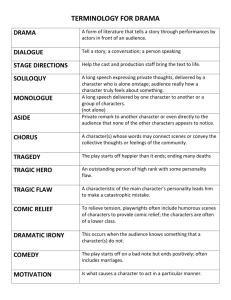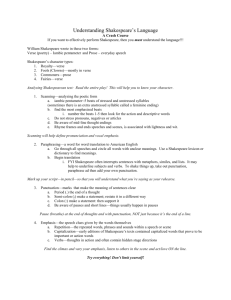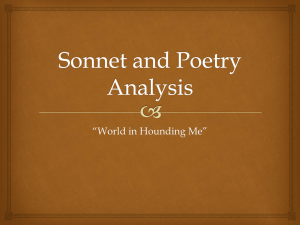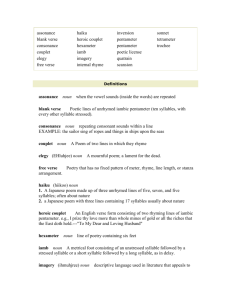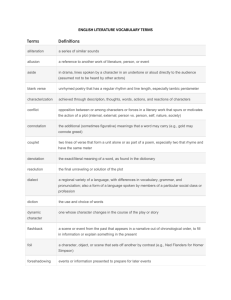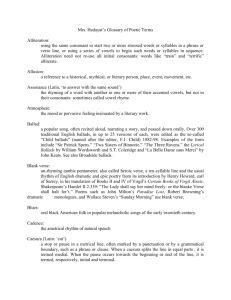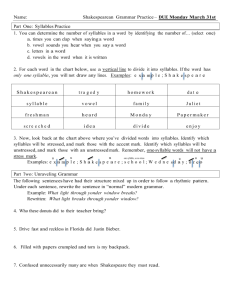Poetic Terms: Abstraction: Theoretical, general, or immaterial
advertisement
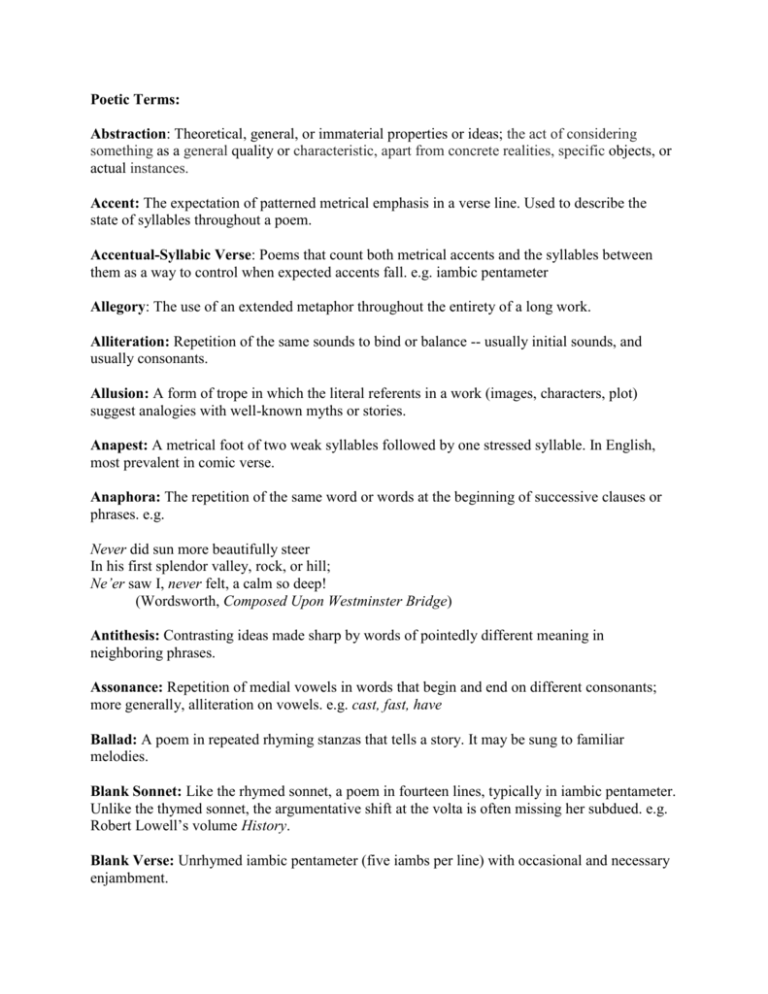
Poetic Terms: Abstraction: Theoretical, general, or immaterial properties or ideas; the act of considering something as a general quality or characteristic, apart from concrete realities, specific objects, or actual instances. Accent: The expectation of patterned metrical emphasis in a verse line. Used to describe the state of syllables throughout a poem. Accentual-Syllabic Verse: Poems that count both metrical accents and the syllables between them as a way to control when expected accents fall. e.g. iambic pentameter Allegory: The use of an extended metaphor throughout the entirety of a long work. Alliteration: Repetition of the same sounds to bind or balance -- usually initial sounds, and usually consonants. Allusion: A form of trope in which the literal referents in a work (images, characters, plot) suggest analogies with well-known myths or stories. Anapest: A metrical foot of two weak syllables followed by one stressed syllable. In English, most prevalent in comic verse. Anaphora: The repetition of the same word or words at the beginning of successive clauses or phrases. e.g. Never did sun more beautifully steer In his first splendor valley, rock, or hill; Ne’er saw I, never felt, a calm so deep! (Wordsworth, Composed Upon Westminster Bridge) Antithesis: Contrasting ideas made sharp by words of pointedly different meaning in neighboring phrases. Assonance: Repetition of medial vowels in words that begin and end on different consonants; more generally, alliteration on vowels. e.g. cast, fast, have Ballad: A poem in repeated rhyming stanzas that tells a story. It may be sung to familiar melodies. Blank Sonnet: Like the rhymed sonnet, a poem in fourteen lines, typically in iambic pentameter. Unlike the thymed sonnet, the argumentative shift at the volta is often missing her subdued. e.g. Robert Lowell’s volume History. Blank Verse: Unrhymed iambic pentameter (five iambs per line) with occasional and necessary enjambment. Breve: The symbol [ U ] used to denote an expected nonaccent in scansion. Anticipated accents are marked by [ - ]. Actual speech stress is marked by a slash [ / ]. Caesura: A stop or pause in a metrical line, often marked by punctuation or by a grammatical boundary, such as a phrase or clause. Clause: A syntactically dependent unit in which a subject and verb occur. Cliche: A phrase with a mass-produced feeling, used automatically and with unvarying sense. Concrete Diction: The opposite of abstraction. Couplet: A set of two lines which act as a unit in a poem, either by an aa bb rhyme scheme or by the poet’s decision to group pairs on lines together on the printed page. Diction: Style viewed from the perspective of word formation, word length, and suggestive complexity. e.g. word choice. Dramatic Monologue: The speech of an invented character with a voice different from the poet’s persona. End-Stopping: Convergence between the end of a line and the end of a sentence. e.g. “It said Why not?/ It said Once more” (Louise Bogan’s “The Daemon”). Enjambment: The continuation of a phrase or clause across the line boundary. Etymology: The origin and history of a word. Foot: A repeating unit of prosody in accentual-syllabic verse, consisting of accented and unaccented syllables. Free Verse: Poetry without any set meter; lines may break either when the unit of syntax is complete or midway through the sentence or clause. Half-Meaning: The provisional or partial meaning created by an enjamed line. Heroic Couplet: Iambic pentameter rhyming couplet, called heroic owing to the subject matter of the verse for which it was first used. Hexameter: A line with six measures or feet. Hyperbole: An exaggerated inflation for rhetorical effect, not meant to be taken literally. Iamb: The basic foot of accentual-syllabic poetry in English: a weak syllable followed by a strong. Iambic Pentameter: Accentual-syllabic poetry, defined as an unaccented syllable followed by an accented syllable in a line consisting of ten syllables. Image: Something physical that is capable of being imagined visually. Can also function as a frame for trope in the form of a metaphor. Kenning: A metaphorical word made up of two substitute nouns in a compound phrase. E.g. “whale-road” for sea; “bone-house” for body. Line: The primary formal unit in poetry; the medium of expression poetry has and prose lacks. Lines are either end-stopped or enjambed into the next line. Metaphor: A transfer of meaning in which one thing is explained by being changed either into another thing or into an emotion or idea. Meter: A definition of how the line of verse behaves. Ode: A poem in praise of nature, public figures, or unimportant events. In addition to conventions of theme, odes often urge a rhetoric of direct address to some person or idea. Onomatopoeia: Imitation of theme by a words sound. Pentameter: Five-measure (ten syllable) lines. Persona: The rhetorical pose that the speaker invents and speaks through. Personification: A type of trope in which the inanimate takes on features of animate or human life and movement. Prosody: The study of poetry. Pun: Humorous use of like-sounding words with different meanings. Quatrain: A four-line rhyming stanza. Lines may be any length and of any measure. Refrain: Repeating phrase, line, or stanza in a poem of many stanzas to give closure in passing. Rhetoric: The art and style of persuasion when referred to acts of speech and writing. Scansion: The visual graph of a poem’s meter, taking into account the number of accents, the expected intervals between accents, and the actual speech-stress of the spoken words. Simile: A class of trope using the word like or as to connect the two parts of the metaphor. Sonnet: A fourteen-line poem, first popular during the fourteenth to seventeenth centuries, with an intricate rhyme scheme and a built-in propensity to shift viewpoint or topic at the volta or turn. Stanza: A group of three or more lines in a poem. Stress: The pressure provided by speech on at least one syllable in a word. Syntax: The way the basic components of a sentence are arranged, connected according to phrases and clauses, and extended to other sentences. Tetrameter: A verse line consisting of four feet (eight syllables). Trimeter: A verse-line consisting of three feet (six syllables). Trocaich Meter: The mirror image of iambic meter- a set of measures with an accented syllable followed by an unaccented one. Trope: The element of poetry that includes all forms of comparison and transfer of meaning. Volta: The change in direction of argument or tone in a sonnet that occurs immediately after line eight.


